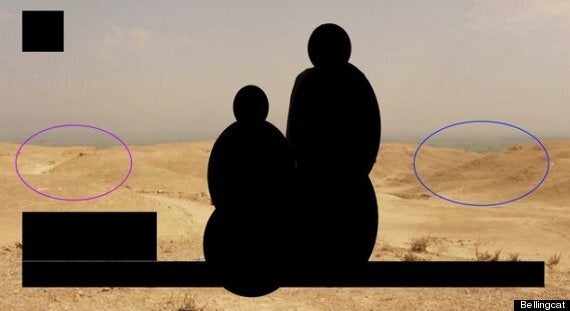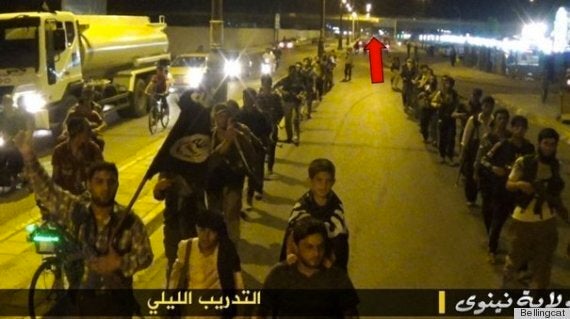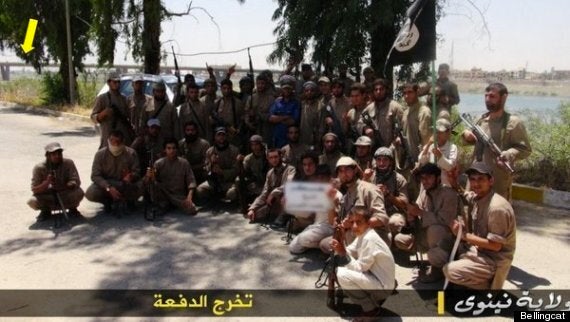For most people who caught a glimpse of the harrowing video where journalist James Foley knelt on a barren, windswept hill next to the Islamic State militant who would behead him, the landscape looked bleak and anonymous.
With no buildings or trees at first glance and a backdrop of just sand and rocks, the site of the killing had been carefully chosen to give no clue to its whereabouts. To the average person the location was as faceless as the hooded knifing-wielding jihadi who would eventually inflict the lethal blows on Foley. But it took Eliot Higgins just a few hours and a cup of tea to zero-in on the exact execution point.
The 35-year-old doesn't work for MI5, and he's technically not an investigative journalist, a ballistics expert, or a human rights activist, although he's rightfully won a reputation has having the best traits of all three. He also doesn't speak Arabic. He left his job in administration at a accountancy firm and lives with his wife and three-year-old daughter in Leicester. But since then, he has dedicated the last two years of his life to watching YouTube videos and following Twitter accounts, becoming an expert in tracking the movements of troops and weapons across the Middle East and beyond.

Eliot Higgins works from home in Leicester
In two years, mostly working entirely off his own back and unpaid except by crowd-funding, he has identified the use of sarin gas in an attack on a rebel-held area of Damascus, was one of the first to note President Assad was using devastating barrel bombs and cluster munitions, revealed the location of a rocket launcher linked to the downing of MH17 in eastern Ukraine, and pinpointed the most likely location of James Foley's murder. And all from his East Midlands living room.
Running his blog under the name Brown Moses, after the Frank Zappa song, Higgins has attracted wild praise from governments, NGOs, activists and journalists. CJ Chivers, a war correspondent for the New York Times once told the Guardian that journalists owed a debt to Higgins and Brown Moses. "Many people, whether they admit it or not, have been relying on that blog's daily labour to cull the uncountable videos that circulate from the conflict," he said.
It is social media that drives much of Higgins work. He subscribes to 1,000 YouTube channels, of which most have a Twitter account. "There's easily 3,000 social media accounts to follow in Syria alone. It needs to be organised, that would make it far more useful to NGOs."
Though the Arab Spring and the subsequent conflicts in Syria and Iraq were defined by the extensive social media use by armies, fighters, activists and civilians, very little practical use is ever made of the information out there.
"I think you could count on the fingers of one hand the number of people who are following these social media accounts this carefully," he told HuffPost UK. "And obviously some think-tanks and the government are following it too, but they aren't necessarily publishing everything transparently like we are."
This week, Higgins launched what he calls his "little media empire", a crowd-funded site costing £47,000 called Bellingcat. Pages views vary, but he gets up to 20,000 visitors a day and many times more than that when he publishes a big scoop.
Unlike traditional journalism, every posting shows his working; the pictures of the line of trees and the curves in the road taken from satellite images from the hills south of the IS-stronghold of Raqqa, Syria, which Higgins matched to the background of the beheading video. It seems perhaps like arbitrary puzzle solving, but in fact, it gives a very clear indication that the remaining hostages are probably being held in that town.

Some of the workings used on Bellingcat to detect the location of James Foley's death, using clues in the background
The new website was basically created due to popular demand. "I went to a camp run by Tactical Tech, with activists from Bahrain and Egypt, and they came to me saying how great my work was. I thought, 'eh? It's just a blog'. So maybe there was more I could do with it."
On the day Higgins published his Foley findings, the site was taken offline by a DDOS (distributed denial-of-service) cyber attack, which all but confirmed to him that he was on the right track. Did he get threats too? "None that I would take seriously, there's lots of nutters on the internet," he said nonchalantly.
More than being threatened on Twitter, Higgins is more concerned that if he slips up, he will be taken to task in the comments section, but the open-source nature of his work is why he prefers working for himself on the internet, rather than intelligence gathering for governments or organisations that would require secrecy. "Working open source you have to provide links, you have to prove everything, and even then you have to be careful. With Foley, as far as I could tell, it was a very likely location. But I didn't say it was definite."
He's pretty sure that he's right, however. "The chances of finding anywhere else like that which matches as well as it does, it'd be pretty rare.
"With this work, rather than one individual thing proving something, lots of things need to add up," he continued. "It increases the chance of something being true. You see a statue in the background, but it might not be a unique statue. But you can also see a similar tree, building or road layout. You need four or five things.
"Sometimes you do get lucky. We were sent a picture of the missile launcher believed to have been used to shoot down MH17 [in Ukraine]. It's a really hard picture, because there's some wires, a lamppost and some trees in the background. I thought 'this'll be tricky'. But we were not only able to find the exact spot, we found a [Google] Streetview image of it, with the same trees in the background. And even though there's a few years' difference between the trees, you can see the shape of the branches is the same. So when you get something like that, that's a very, very strong indication."
Higgins was, up until 2012, working in administration but also engaged nightly in heated debate on many internet discussion forums about the Arab Spring. He is a self-confessed pedant. "I started by trying to match pictures up with other pictures. Video will be posted on a forum, and then someone would say it was a certain kind of tank. Then I would check if they were right," he grinned.

Much of Higgins' work has made international news
Brown Moses started like any other amateur blog as a place for him to air his opinions and ask questions. But his sleuthing began to attract the attention of experts. "I started to build up a network who could help. I once identified a BM-30 Smirch Cluster rocket and I actually used holiday snaps someone had posted from their trip to a Russian military museum.
"That was the only hi-resolution image of the rocket I could find online. Sometimes, a lot of the good hi-resolution imagery of these weapons comes from museums and air shows. People come along with their 4000x4000 super cameras and post it on their Flickr accounts. You have to use lots of different sources when you're looking for this stuff."
When Higgins has been profiled in the past, some of his expertise has been attributed to his gamer days, but it wasn't military games like 'Call of Duty' that he was into. "Most people can recognise an AK47 anyway, so those games wouldn't be that useful. That was my level on knowledge before, to be honest," he said.
Higgins was actually a dedicated player of role-playing and strategy games like World of Warcraft, perhaps not on-the-face-of-it useful for understanding the way Syrian rebels are operating.
"I was speaking to someone who said that what I do reminded him of the mystery games from the '80s and '90s, where you'd get a cloth map in a box and you'd have to locate things," he said. "In a funny way, it's kind of the same principle. It's using codes, maps, working out puzzles. It's puzzle-solving. If anything, that's what I attribute it to. Not Call of Duty."
The level of dedication and the amount of interest his blog and now his new Belingcat site has generated has "frankly amazed" his family, Higgins said. "All of a sudden I've gone from working in administration for an accountancy firm to setting up a little media empire. But I have just done what has seemed to be the best, most interesting thing to do at the time."
Higgins said he is "not actually surprised" that the work he does isn't done by anyone else, even journalists, because it is "immensely time-consuming". The work should act as an intelligence resource for journalists, he said. "When we were focussed on MH17, journalists who were on the scene in Ukraine would go to the places we were writing about and ask questions based on our work. That's the kind of thing I want to achieve."
The amount of footage and data that is now available "kinda overwhelms people" he said. "No one actually takes real notice of how much information is contained in social media posts. Where do you start with it? And the only way I have been able to do it is manually."
The technology is "not actually available" to allow Higgins to work anywhere near as efficiently as he would like. He follows at least 700 Syrian opposition groups on Facebook, mostly directly linked to specific movements or towns, who are posting real time information on strikes in their areas, but he admits that keeping track of them just via his Facebook wall is "next to impossible". He is working on tools with a media company, who originally developed their platform to follow the social media accounts of football teams, to track the varied Syrian opposition groups.
"I once identified a BM-30 Smirch Cluster rocket using holiday snaps"
Many of his days are spent wading knee-deep in the misinformation and disinformation that floods social networks when people panic or intend to spread fear. In 2012, it had made serious analysis into Assad's alleged chemical weapons use all but impossible.
"It got to the point where everything out of the ordinary was a 'chemical weapon'," Higgins said. "In May, there were white fibres showing up all over the place, and everyone said it could be chemical weapons, with no evidence it was - at all. And I found out that this rumour was spread during the Balkans war as well, it's something to do with insects mating, and leaving some fibres behind."
Most of his work became about debunking. Pictures of glass test-tubes found in Syria were rife across social media as proof of chemical attacks. Higgins found they were standard issue testing kits issued to armies, and were even available on eBay. "You cannot take anything at face value," he said.
The 2013 sarin gas attack on Damascus on August 21 was different. Higgins worked for days on pictures, satellite locations and YouTube clips to give the clearest proof published to the public that the attack had taken place and probably come from Assad forces. He found where one of the rockets landed, published photos showing how similar munitions had been used in other chemical warfare, and that one particular rocket examined by the United Nations could practically have been loaded with more than four pounds of sarin.
"I don't think anyone's got the same amount of knowledge as I do," he said, citing the investigation as his proudest scoop. And he is still working on it. Chemical weapons experts now approach Higgins with their theories, and his next big reveal involves the "miscellaneous" chemicals detected by the UN report. "We didn't know where some of them had come from. They were by-products of sarin. You can then tell a lot about how it was made. The Syrian government declared 80-tonne of hexamine as part of the chemical weapons programme. Well, then any indication we get that the sarin gas released had some hexamine, seems to be a way to link the Assad government even further to the sarin use on August 21st.
Story continues below the slideshow
He was leaked fake information regularly during his investigation, one purporting to show Liwa al-Islam, an Islamist opposition group, with the equipment needed to fire chemical weapons. It was designed to show that rebels had access to the sarin gas too, but Higgins was suspicious. The video was blurry, unlike the slick and professional ones the group had made its name with. It was also extremely dark, and August 21 was a full moon. The group had also purportedly draped their weaponry in their flags, which they had never done before. Posting it on his blog, Higgins questioned its authenticity, and the group responded, saying they had no such weapons at their disposal.
Higgins has expressed frustrations too about the way the gas attack was reported. Veteran US investigative journalist Seymour Hersch published a 5,000 word essay in the London Review of Books, citing security sources who cast doubt that Assad was responsible for the attack. It was an old school way of reporting, relying heavily on contacts and briefings. "There were things posted on the Syrian government's own social media accounts that contradicted what he was saying," Higgins said. So he wrote a rebuttal, in just over a quarter of the word count, for Foreign Policy.
Other than his day-to-day work looking at the movement of weapons in Syria, and thus identifying the governments and regimes who are funneling in weapons, he hopes his next big scoop will be on the Islamic State. "We are trying to get more pictures of 200 Syrian soldiers who were marched into the desert and supposedly killed," he said. "If there has been such a mass execution, there will be mass graves, and you can find that through satellite mapping. That will be very valuable from a war crimes perspective."
Though much of the work is time-consuming, he said it is actually far easier than people think, if you know where to look. He cites his investigation into an Islamic State training camp in Ninewa Province, Iraq, using photos found on JustPaste.it.
"When I did the piece on the [Islamic State] training camp, I thought it was pretty boring to be honest, straightforward geo-location. It wasn't a big deal. But it got a huge response, people just don't realise how easily you can do this stuff."


Similarities in the images posted on social networks basically gave away the location of the training camp
"I did some stuff for Reuters on Russian military in Ukraine, helping them work out where a particular crater was, and the direction of the crater was pointing toward the Russian border," he added. "It took me 20 minutes with a cup of tea to basically show stuff was coming in across the Russian border. But you have to know where to go to get the pictures. I use Panoramio [a photo-sharing and geo-location site run by Google]. If you don't, you could spend ages working it out.
Higgins says he has been approached by educators to speak to young people about how they can help with work like his. But he said that, actually, lecturing students is a "good way to warn them of the dangers" of social media.
"It's ridiculous, some of these Russians are posting Instagrams with geotags from military bases on the Ukrainian border. It's great for me though," he said. "It's actually astonishing that people put some of this stuff out there but they do."
Though Higgins says he has no "great masterplan for a lot of it", that is not quite true. Bellingcat is an ambitious endeavour, hoping to combine the work of investigative citizen journalists and activists across the globe, and will branch out beyond war reported. He is involved in setting up, along with the Organised Crime and Corruption Reporting Project, a group to look at cross-border crime, using business records.
"Money-laundering requires business records, they have to have a legitimate business. Then it will have names of directors on there, etc and you can start piecing together crime networks. It's complex but possible, and we are training a dozen people in London, but eventually in different cities across the world.
"We can teach these skills to journalists, and they are very transferrable. It will, I think, mean it becomes very, very difficult to do those kind of corrupt practices in future."
Knowing what he has been able to achieve in two years should be "empowering" to people that they can do the same, he said. "They are big, serious, topics, but if I can take them on from my living room, anyone can. I had no special training. It's better than doing a Sudoku in the evening, and probably more enjoyable."

